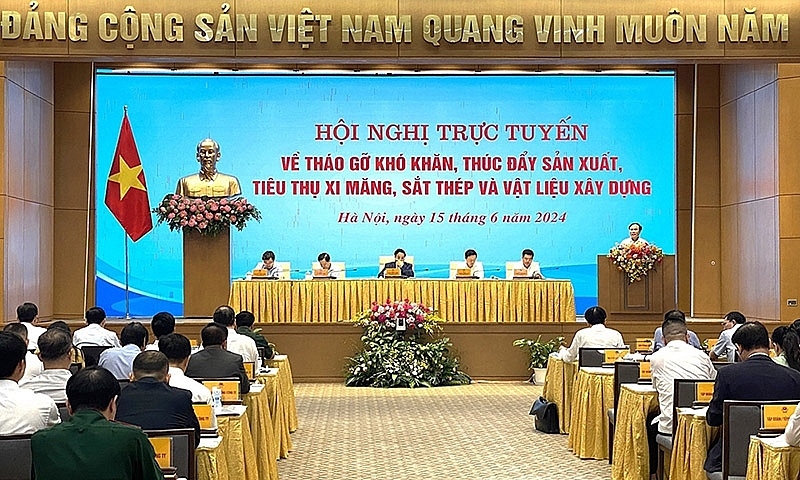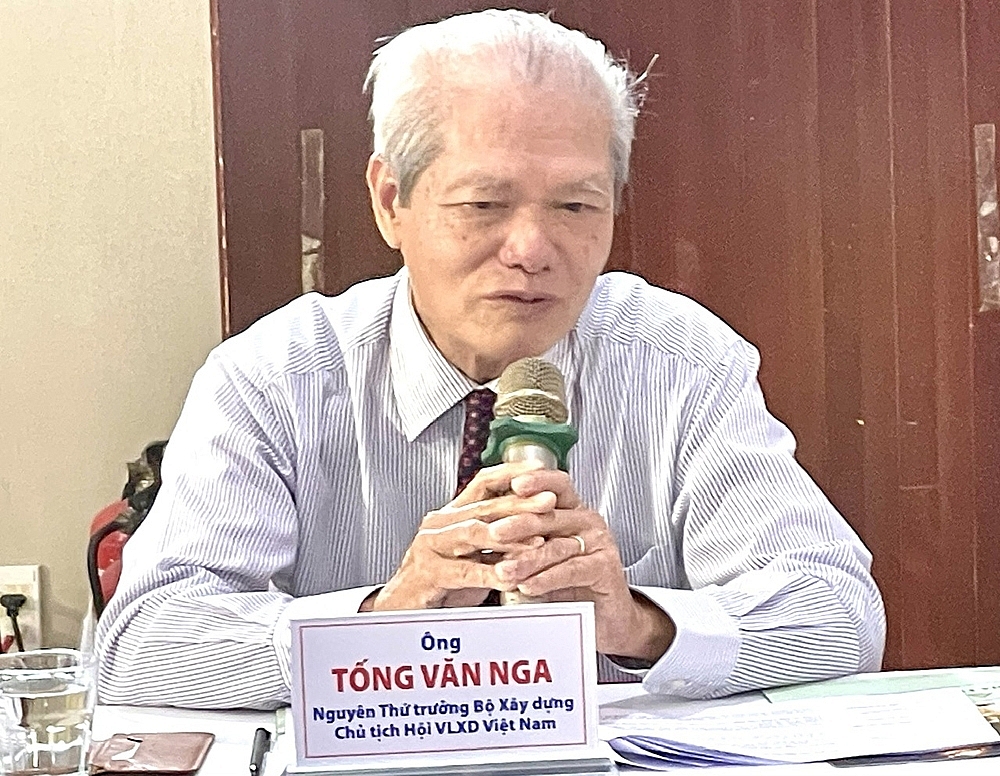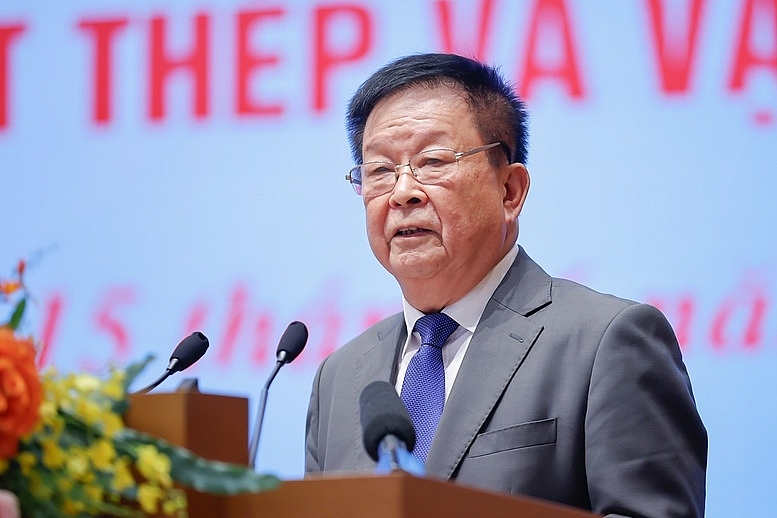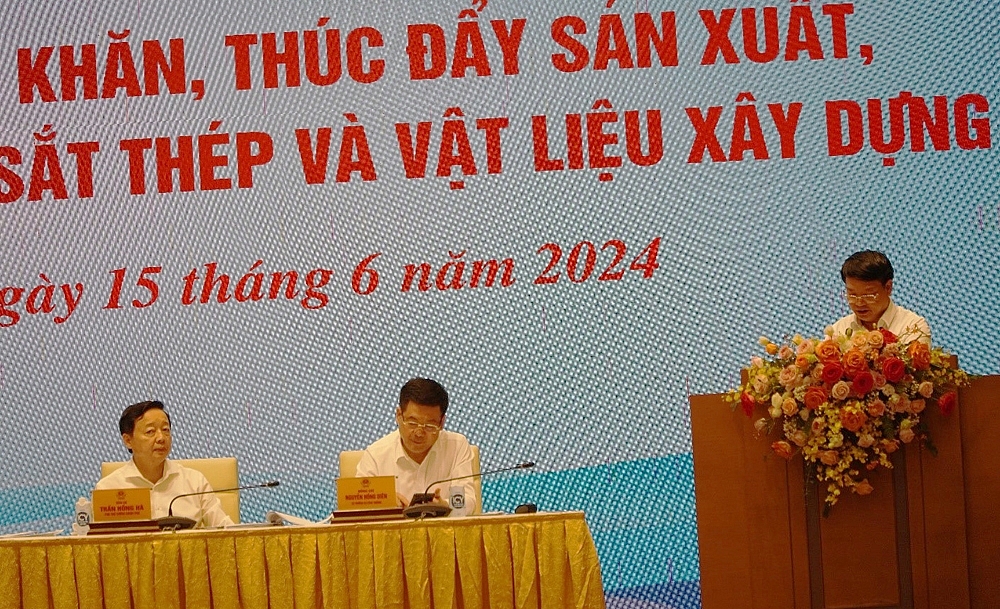Notable News

30/11
At the online conference on removing difficulties and promoting production and consumption of cement, iron, steel and construction materials, chaired by Prime Minister Pham Minh Chinh, representatives of associations and businesses spoke Recommend a series of difficulties and propose solutions to the Government, ministries and branches.
|
|
|
Overview of the online conference. |
Mr. Tong Van Nga - Chairman of the Construction Materials Association: Through the plains and rice fields, build a viaduct
The construction materials industry over the past 30 years has developed in the right direction, promptly and effectively. Construction materials reach world advanced levels; not only meets domestic demand, but also exports to earn foreign exchange. The industry is facing many difficulties and needs urgent solutions and direction from the Government.
|
|
|
Mr. Tong Van Nga - Chairman of the Construction Materials Association. |
Currently, the real estate market is quiet, commercial housing projects are almost frozen, the Government has directed to focus on developing social housing, developing 1 million apartments is feasible. The Association recommends that when localities plan for industrial parks and export processing zones, they must plan for urban areas, including planning for social housing; Industrial park investors are investors in urban areas and social housing. The employing enterprise registers the number of apartments and the area to be used. Social housing is mainly for rent, if sold, few people can afford to buy. Carry out bidding for construction and installation according to the approved design, do not assign it to urban investors because they will focus more on profits and apply assembly construction.
The Association recommends increasing the use of cement in road construction, specifically to build viaducts in the Mekong Delta with weak soil, because of its high durability, 50-100 year lifespan, and little site clearance. quickly, save rice fields, and proactively respond to climate change; low maintenance costs. Building highways will avoid subsidence, solve the current problem of lack of land for roads, and reduce asphalt imports and foreign exchange costs. We adhere to the Prime Minister's guiding motto: Build bridges across streams, dig tunnels across mountains; The Association would like to propose a third point: to build a viaduct across the plains and rice fields.
Mr. Nguyen Quang Cung - Chairman of Vietnam Cement Association: Remove clinker and cement from the group of taxable export goods
The Cement Industry recommends that the Prime Minister, ministries and branches have solutions to increase domestic cement consumption. In addition to early construction of viaduct roads in appropriate places; Reinforcing the roadbed with cement is a feasible solution. Currently, we dig up the roadbed soil, dump it, and then fill it in with filling materials. If the roadbed is reinforced with cement, the soil will be used on-site, bringing durability to the roadbed, reducing water absorption, distributing loads more evenly, increasing longevity and reducing construction maintenance costs. This technology was used by European and American countries hundreds of years ago and is currently being used.
|
|
|
Mr. Nguyen Quang Cung - Chairman of Vietnam Cement Association. |
Proposing the Government to remove clinker and cement from the group of export goods numbered 211 of Appendix I - Export Tariff according to the list of taxable goods of Decree 26/2023/ND-CP dated May 31 /2023 when amending this Decree. According to Article 1 of Decree 146/2017/ND-CP, exported clinker and cement products are subject to a value-added tax rate of 0% if during the export process, enterprises fully meet the requirements. requirements of Clause 2, Article 12 of the Law on Value Added Tax.
Cement production technology is the best technology to treat waste, including hazardous waste due to very high combustion temperatures, above 1500oC. The Association recommends that the Government direct relevant State agencies to have policies to encourage finance, procedures, taxes and fees for the investment and operation of co-processing and reuse equipment. waste in cement factories. Promulgating policies on exemption, reduction, and deduction of greenhouse gas emission targets for businesses using raw materials and alternative fuels such as waste and waste, and using electricity produced from power stations using furnace exhaust gases. calcination in production.
Mr. Le Quang Hung - former Deputy Minister of Construction, Chairman of Vietnam Concrete Association: Increase the rate of viaducts to 20 - 30%
To increase domestic cement consumption, we believe that it is necessary to increase the housing construction area, including social housing, to both solve the housing problem for low-income people and stimulate demand for cement and concrete consumption. cardboard. At the same time, increase the rate of viaduct construction.
|
|
|
Mr. Le Quang Hung - former Deputy Minister of Construction, Chairman of Vietnam Concrete Association. |
According to statistics, on highways, the rate of using viaducts and tunnels is just under 10%; That is, 1,000km of highway is only about less than 100km; The Saigon - Trung Luong Expressway alone is up to 30% used. We can increase the viaduct ratio to 20 - 30%.
Regarding costs, if the entire project life is 40 years, the Ministry of Transport calculates that the investment fee for the viaduct will only increase about 1.4 - 1.5 times more than the embankment, not 2 - 2.5 times. as originally calculated, because the viaduct has no maintenance costs. Second, building a viaduct reduces construction time. If with the current method, construction and waiting for subsidence takes 36 months, the viaduct only takes about 22 months; reduce land clearance area, respond to climate change, and flood drainage; good quality control and solving the problem of scarcity of embankment land in the Mekong Delta.
Mr. Dinh Quang Huy - Chairman of Vietnam Ceramics Association: No investment license for new ceramic tile projects
The Association recommends planning raw material areas linked to production areas. In the field of tiles, investment is only allowed to replace outdated production lines, no new investment licenses are granted.
|
|
|
Mr. Dinh Quang Huy - Chairman of Vietnam Ceramics Association. |
It is recommended that the Government accept the certification process for imported goods, allowing upstream inspection of imported ceramic tile products into Vietnam similar to the certification process of Thailand, Malaysia, Indonesia... is being implemented for Vietnamese products. There are regulations on sending a delegation to inspect the production factory to ensure the quality of goods before import. Customs documents meet the requirements, plus upstream inspection meets the requirements to receive customs clearance.
In the past few years, Indian ceramic tiles imported into the Vietnamese market accounted for 50% of total imports, causing damage to the domestic production industry. The association and businesses are initiating an anti-dumping investigation against imported tiles from India. This is also a practical measure to protect the domestic market and Vietnam's tile production industry. The Association requests that the Government and the Ministry of Industry and Trade support this lawsuit.
Mr. Nguyen Quoc Viet - In charge of the Board of Members of Vietnam Cement Corporation: Removing problems with natural resources tax
In recent years, VICEM has focused on innovation and improving production lines to reduce production costs, especially reduce coal depreciation, and use low-grade, cheap coal products. Focus on investing in construction projects that utilize excess heat to generate electricity, especially VICEM has used waste, by-products, and waste products from other industries such as gypsum, ash, slag... Focus on digitizing business, currently Almost all cement companies place orders online.
|
|
|
Mr. Nguyen Quoc Viet - In charge of the Board of Members of Vietnam Cement Corporation. |
Vietnam Cement Corporation is ready to participate in modernization of agriculture and rural areas, public investment projects, and sales with deferred payments. Taxes other than clinker tax and natural resources tax still have many problems. Tax is currently calculated in two ways: tax according to the Provincial People's Committee, or calculating the selling price minus production costs. Inadequate tax calculation does not encourage businesses to make efforts to reduce production costs. It is recommended to agree on the price issued by the Provincial People's Committee.
Mr. Eamon Ginley - General Director of INSEE Vietnam Company: Proposal to reduce interest rates for home buyers and builders
Interest rates, Land Law 2023 and Real Estate Law 2023 are core factors to help stimulate market demand. Quick implementation of new regulations is important. Floating interest rates for borrowers to buy and build houses need to be reduced below 9% and interest rates for small and medium enterprises need to be reduced further. Cement companies must save themselves, by ensuring sustainable business and the lowest possible production cost structure. Sustainable business in the Cement industry requires efficient energy management, high co-processing ratio and low clinker coefficient in cement products.
INSEE Vietnam has been using waste materials to replace coal for more than 15 years, through co-processing activities. The main product has 40% lower CO2 emissions than traditional OPC cement. The company proposed that the Government consider co-processing activities to be recognized as one of the solutions to meet EPR (extended producer responsibility), penalizing businesses that do not comply with this responsibility. Government projects should not limit the use of OPC cement, when PCB mixed cement is better for the environment, has better sulfate resistance properties, and has the ability to be equivalent (or superior) to OPC in the application.












